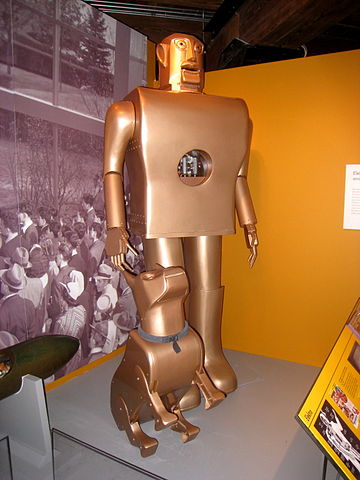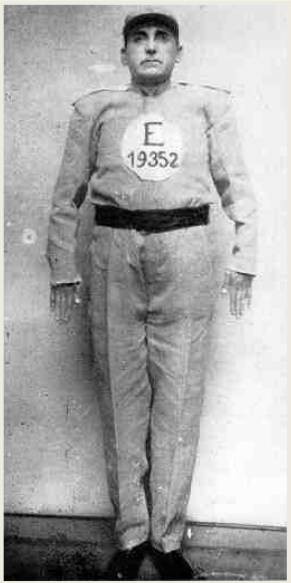By Sidney Perkowitz (Atlanta Science Tavern contributor)

Robot as clanking machine. Elektro and his dog Sparko, made by the Westinghouse Corporation, as they appeared at the 1939 New York World’s Fair (Senator John Heinz History Center).
Among cutting-edge technologies, robotics ranks high when you think of all it entails – or at least, all it would entail to make robots as seen in fiction. A robot like those Isaac Asimov made famous is typically a somewhat humanoid metal machine that walks, talks, sees, hears, and understands, and acts autonomously. If in addition it looks almost perfectly human, it becomes an android like Commander Data in Star Trek or David in the film Prometheus (2012). Making these would require advanced technology we have yet to develop. But artificial beings date back to Talos in Greek myth, a bronze creature that guarded the island of Crete, and to the Golem, a creature made of clay that protected the Jews of Prague in medieval times, among others.
These are not robots, however. Robots were born later, on January 25, 1921 and as it happens, also in Prague, at the world premiere of Karel Čapek’s play R. U. R. (Rossum’s Universal Robots).
Čapek was a productive Czech writer with wide-ranging ideas. In R. U. R. he imagined a future in which humanity makes artificial creatures called “Robots” (always capitalized in the script and actually coined by Čapek’s brother Josef) after the Czech word “robota,” which means forced labor by a serf, or “robotnik,” meaning “worker.” Indeed, these synthetic beings are manufactured to carry out the drudgery that people do not want to. Unsurprisingly, they come to understand that they are being exploited and rise up with great violence, killing all humanity except for a single survivor.

Robot as artificial protoplasm, from the original stage production of R. U. R., Prague, 1921. (Image reproduced from the works of Prof. Jana Horáková, Masaryk University, Czech Republic, with her permission.)
These ideas, novel at the time, made the play a worldwide sensation then (by 1923, it had been translated into thirty languages) and have kept it alive since. It is constantly being revived; it inspired Gizmo, a contemporary play about robots by Anthony Clarvoe, first presented this year; and in title at least it has also inspired a film called R. U. R., due for release in 2014.
The play also presents broader themes because, despite the robots, it is not about technology but about people and technology. As Čapek wrote in 1923, “For myself, I confess that as the author I was much more interested in men than in Robots.” One theme is the fear of machines replacing people, still an issue today. Another is a moral one: what are humanity’s responsibilities toward sentient beings it might create? The humans in R. U. R. either treat the robots like unfeeling machines, or uplift them by making them more nearly human. Neither works well, leading to the play’s robot revolution and illustrating that this is a hard question that we might have to answer sooner than we think.
In a way, R. U. R. also foretold the biological engineering that is now taking halting steps toward creating artificial life. The robots in the play are not clanking metal constructions, but made of a substance “which behaved exactly like living matter” – synthetic protoplasm processed to make robots complete with brains, livers, nerves and veins. The results look human, not machine-like, and that’s where the power of R. U. R. lies: it makes us see ourselves in our robots, and our robots in ourselves.
Sidney Perkowitz is Candler Professor of Physics Emeritus at Emory University. His varied popular science writing includes the book Digital People, articles, and blogs about robots, most recently with this post at the Science and Entertainment Exchange. You can find out more about Sidney’s work and contact him at his website.
